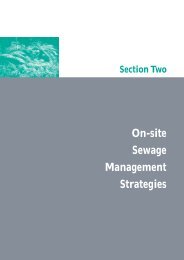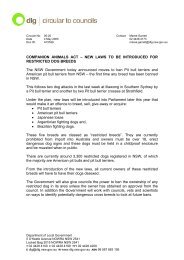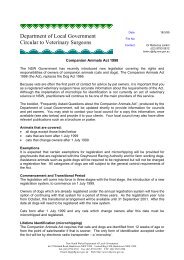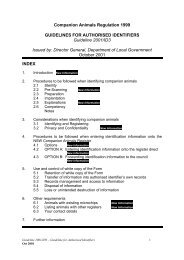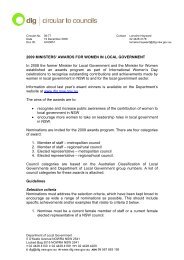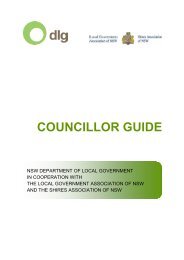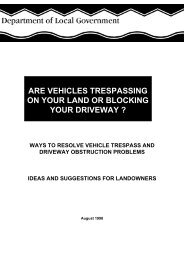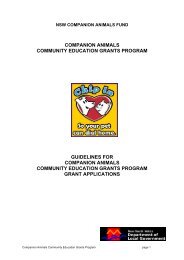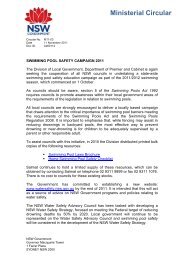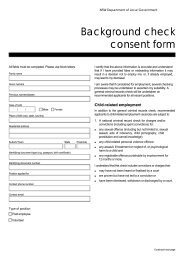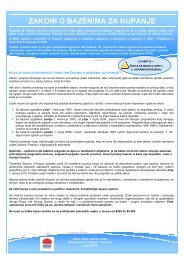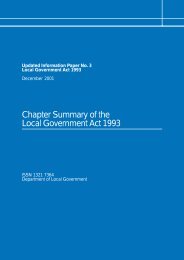Integrated Planning and Reporting Manual - Division of Local ...
Integrated Planning and Reporting Manual - Division of Local ...
Integrated Planning and Reporting Manual - Division of Local ...
You also want an ePaper? Increase the reach of your titles
YUMPU automatically turns print PDFs into web optimized ePapers that Google loves.
2. THE COMMUNITY STRATEGIC PLAN<br />
One <strong>of</strong> the problems identified with existing monitoring programs is that data collected at the local<br />
level is not used to inform environmental reporting at higher levels - regional, state <strong>and</strong> national.<br />
Some <strong>of</strong> the problems have been the use <strong>of</strong> different methodologies for data collection <strong>and</strong><br />
inconsistency in collection.<br />
Councils should engage with their local Catchment Management Authority <strong>and</strong> other relevant<br />
organisations in their area to come up with a system <strong>of</strong> monitoring, evaluation <strong>and</strong> reporting that<br />
involves collaboration across the various levels (local/regional/state).<br />
The new framework establishes a number <strong>of</strong> opportunities for councils to work with each other, <strong>and</strong><br />
with other groups <strong>and</strong> agencies in environmental management, monitoring <strong>and</strong> reporting. For<br />
example, councils should consider participating in regional state <strong>of</strong> the environment-type reviews to<br />
help inform the Community Strategic Plan in their local government area.<br />
There is also opportunity to draw from a wider range <strong>of</strong> data, to form partnerships or data-sharing<br />
arrangements for environmental monitoring across a region with shared environmental features.<br />
An example <strong>of</strong> this approach is the 2007/08 Namoi Regional State <strong>of</strong> the Environment Report. The<br />
Namoi region includes five local government areas. The purpose <strong>of</strong> the Regional State <strong>of</strong> the<br />
Environment report is to provide relevant data <strong>and</strong> research, <strong>and</strong> assess environmental issues to<br />
inform the development <strong>of</strong> long-term strategic plans <strong>and</strong> shorter term operational plans for councils<br />
in that area.<br />
The Namoi Regional State <strong>of</strong> the Environment reports aim to:<br />
promote a big picture underst<strong>and</strong>ing <strong>of</strong> the environmental issues across the region<br />
identify external influences <strong>and</strong> pressures impacting on the environment<br />
provide clarification <strong>of</strong> the roles <strong>and</strong> responsibilities for particular environmental issues, <strong>and</strong><br />
the role that councils may play (advocate, service provider, regulator, or facilitator) in<br />
responding to these<br />
identify links to the NSW State Plan <strong>and</strong> Namoi CMA targets<br />
to integrate with the Namoi Catchment Sustainability Plan<br />
identify opportunities or appropriate responses<br />
suggest processes to assess the effectiveness <strong>of</strong> responses <strong>and</strong> ensure an effective<br />
continual improvement loop.<br />
It is essential that councils include sufficient emphasis on environmental assessment to satisfy their<br />
community that the environment is being effectively managed <strong>and</strong> protected.<br />
Assessment example: Promoting Active Living<br />
Many communities identify ‘healthy active communities’ as a key objective <strong>of</strong> their long-term plans –<br />
but how does a community determine if its actions are actually having an effect<br />
The Premier’s Council on Active Living (PCAL) has considered this issue <strong>and</strong> consulted with state<br />
<strong>and</strong> local government stakeholders to develop a list <strong>of</strong> ten key areas that could be sampled. The list<br />
is based on the underst<strong>and</strong>ing that the physical environment <strong>of</strong> an area has an effect on the<br />
physical activity <strong>of</strong> its residents.<br />
The indicators are comprehensive <strong>and</strong> it is not intended that councils should monitor everything on<br />
the list. Councils may wish to choose the measures that best suit their situation, priorities <strong>and</strong><br />
resources. For example, one item from each <strong>of</strong> the ten key areas would provide a good collection <strong>of</strong><br />
evidence to indicate progress in promoting active living. As can be seen from the list, some<br />
evidence will be quantitative – facts <strong>and</strong> figures from various sources, <strong>and</strong> some will be qualitative –<br />
the way people feel about things.<br />
<strong>Planning</strong> & <strong>Reporting</strong> <strong>Manual</strong> Page 52 <strong>of</strong> 115



